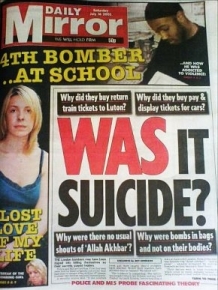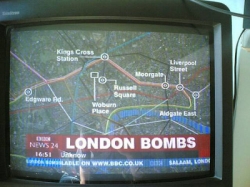An Overview of Events on July 7th
The Official Story: An Official Confusion
 The 'official story' of July 7th 2005 is that 52 were killed and 700 were injured when 'almost simultaneous' explosions ripped through three London Underground trains before, just under an hour later, a fourth explosion occurred on a number 30 bus that had been diverted from its normal route.
The 'official story' of July 7th 2005 is that 52 were killed and 700 were injured when 'almost simultaneous' explosions ripped through three London Underground trains before, just under an hour later, a fourth explosion occurred on a number 30 bus that had been diverted from its normal route. Initial reports from the train operating companies suggested that the explosions and devastation on the Underground were the result of train collisions, electrical failures and power surges. Shortly after the apparent explosion of a number 30 bus, at 947am outside the British Medical Association headquarters in Tavistock Square, a very different version of events began to unfold.
The first story to emerge was of up to six explosions on the underground with the timings staggered over the space of an hour. The times of the underground explosions were initially reported as being 8.51, 8.56 and 9.17.
Underground Explosions
 Morning radio and television news soon began to fill with news of an incident on the underground in the Liverpool Street area.
Morning radio and television news soon began to fill with news of an incident on the underground in the Liverpool Street area. Few details were available in the early stages but commuters who had not already entered the underground system were warned to stay away from trains, buses and central London in general. Reports of incidents at multiple locations soon began to appear and a total of six separate incident locations were reported by mainstream media. At 10:20am on July 7th, the Metropolitan Police web site confirmed that a major incident had been declared, although it was "too early to state what had happened at this stage." The announcement also stated that, "Police are responding to reports from: Edgware Road, King's Cross, Liverpool Street, Russell Square, Aldgate East, Moorgate underground stations."
As the details started to emerge, the explosions were said to be staggered over the space of an hour. By 4:30pm the Metropolitan Police were reporting the following timeline of events on their web site:
At 08.51 on 7 July at Liverpool Street Station there was a confirmed explosion in a carriage 100 yards into the (Liverpool Street-bound station) tunnel.At 08.56 there was another incident at King’s Cross / Russell Square. Both stations were used to bring out casualties. Walking wounded came up from the line at King’s Cross. There were seven confirmed fatalities, 10 seriously injured people and 100 walking wounded in this incident. All those who were injured have now been treated, and at 12.30 the London Ambulance Service withdrew from Russell Square.Two mortuaries are being set up - these are at the Royal National Hotel and the Holiday Inn in Bloomsbury. There are 21 confirmed fatalities and others with injuries from these two incidents.At 09.17 there was an explosion on a train coming into Edgware Road underground station approximately 100 yards into the tunnel. The explosion took place on a train and blew through a wall onto another train on an adjoining platform. There were five fatalities and others injured in this incident. Three trains are believed to have been involved.
Many other news outlets, including the BBC, reported these blast times and BBC News 24 was still reporting 7 explosions across London at 4.51pm.
At 11am on July 8th, the Metropolitan Police stated that: 'there is no evidence to suggest that the attacks were the result of suicide bombings although this cannot be ruled out.' [Metropolitan Police]
On July 9th the timing of the explosions on the Underground was revised considerably. The blasts timings changed from those above to have occurred 'almost simultaneously' at 8.50am. Scotland Yard reported the Underground incidents occurred within 50 seconds of each other, despite the original timings spaced over 26 minutes.
How did the original stories of power surges, train collisions and derailments with staggered times turn into simultaneous suicide bombs? Could the transport management companies involved with running London's underground really have got the cause of what happened on the underground so wrong?
"You could have had a power surge with a quite catastrophic casualty level. We have always been aware of that on the Underground."Ken Livingstone
7th July Review Committee, March 1st, 2006
The Tubelines consortium of train operating companies reported the incidents with rather different information about the affected train lines, stations and the directions in which the trains were travelling:
Transport For London reported the following:At 09:46, the London Underground was suspended and all stations commenced evacuation following incidents at: Aldgate station heading towards Liverpool Street station on the Hammersmith & City line; Russell Square station heading towards Kings Cross station on the Piccadilly line; and Edgware Road station heading towards Paddington station on the Hammersmith & City line. [Tubelines]
14:25 Transport for London Update
Latest information confirms that there were four incidents on London's transport network this morning, three on London Underground and one on London Buses.
At 09:46, the London Underground was suspended and all stations commenced evacuation following incidents at:
- Aldgate station heading towards Liverpool Street station on the Hammersmith & City line;
- Russell Square station heading towards Kings Cross station on the Piccadilly line;
- Edgware Road station heading towards Paddington station on the Hammersmith & City line.
Source: TFL Press Release
Who released the correct information, the train operating companies, or the police? Notice that both TFL and Tubelines report that the Piccadilly Line train was heading towards King's Cross and that the Hammersmith & City Line was affected, rather than the Circle Line as later reported.
Number 30 Bus Explosion, Tavistock Square
Fifty seven minutes after the 'almost simultaneous' explosions on the underground, an explosion occurred outside the British Medical Association headquarters on a number 30 bus that had been diverted into Tavistock Square. Footage of the bus showed that the roof had been lifted clean off the bus and a number of people were left standing on the top deck after the explosion occurred who looked otherwise unharmed.
At the time of the explosion the bus was just outside the BMA and a number of offices housing companies from a wide range of industries including the transport and transport security industries.
The Metropolitan Police reported the number 30 bus explosion as follows:At 09.47 there was an explosion on a bus at Upper Woburn Square junction with Tavistock Place. There are fatalities on the bus but it is not known how many. We estimate many casualties.
Immediately after the bus explosion, Sky News was told to pull its helicopter out of the skies and very little footage now exists in the public domain of the bus in the immediate aftermath of what happened. A number of photos exist showing the bus at various stages of the day and these will be added to the site shortly.
According to a testimony given by a July 7th survivor to the 7 July Review Committee on March 23 2006, a meeting was due to take place that morning in Lynton House, 7-10 Tavistock Square, that had been called at the last minute on July 6th, immediately following the news that London had won the 2012 Olympic bid.
The witness told the 7 July Review Committee that she had provided information about the meeting anonymously to police as she believed it may have some connection to the bus explosion outside her company's head office in Tavistock Square.
The information was provided anonymously after her employers warned that talking about the events of July 7th to anyone, especially to the media, was forbidden and would result in instant dismissal.


No comments:
Post a Comment